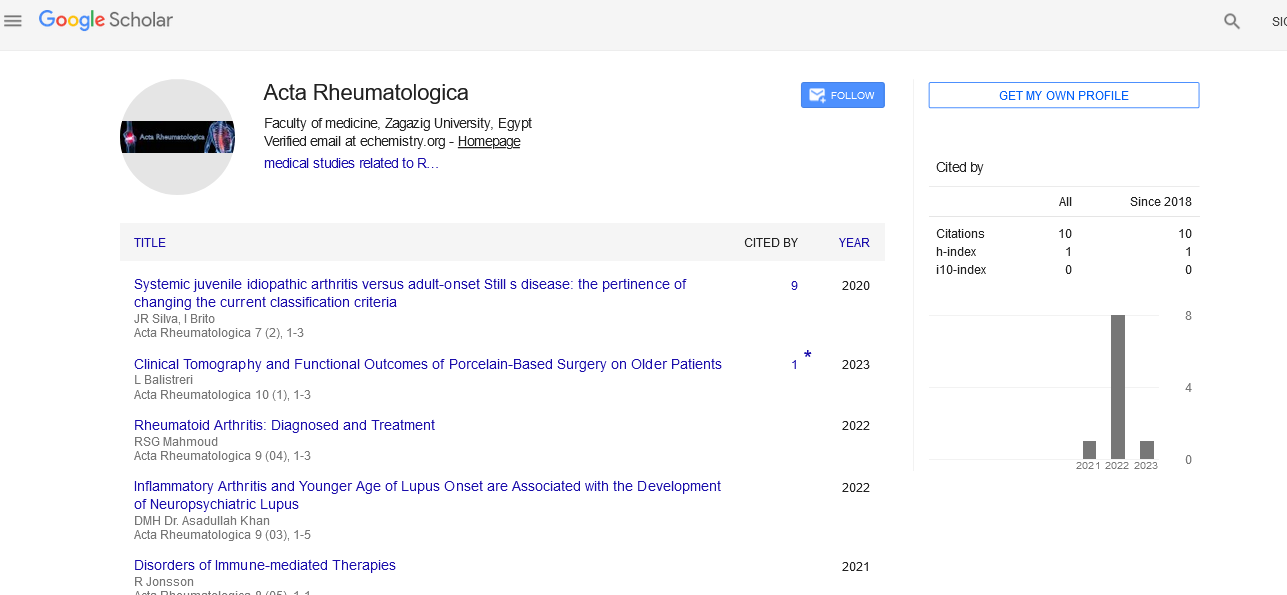Perspective - (2023) Volume 10, Issue 5
Understanding Calf Muscle Pain: Causes, Treatments, and Prevention Strategies
Jamal Rahmani*
Department of Department of Rheumatology, Science and Technology, University of Kashan, Iran
*Correspondence:
Jamal Rahmani, Department of Department of Rheumatology, Science and Technology, University of Kashan,
Iran,
Email:
Received: 12-Sep-2023, Manuscript No. ipar-23-14254;
Editor assigned: 15-Sep-2023, Pre QC No. ipar-23-14254 (PQ);
Reviewed: 03-Oct-2023, QC No. ipar-23-14254;
Revised: 10-Oct-2023, Manuscript No. ipar-23-14254 (R);
Published:
18-Oct-2023
Introduction
Calf muscle pain is a common complaint that can range
from mild discomfort to severe agony, impacting mobility
and daily activities. The calf muscles, located at the back
of the lower leg, are crucial for movements like walking,
running, and jumping. Understanding the causes,
effective treatments, and preventive measures for calf
muscle pain is essential for managing this condition.
Causes of calf muscle pain
Muscle strain: Straining the calf muscles due to overuse,
sudden movements, or inadequate warm-up can cause
pain, leading to micro-tears in the muscle fibers.
Overexertion and exercise: Intense physical activities,
especially those involving sudden or repetitive movements
such as running, jumping, or sports like basketball or
tennis, can strain the calf muscles, leading to pain and
soreness.
Dehydration and electrolyte imbalance: Inadequate
hydration or an imbalance in electrolytes, particularly
potassium, magnesium, and calcium, can contribute to
muscle cramps and pain in the calves.
Peripheral Arterial Disease (PAD): Reduced blood flow
to the legs due to narrowed arteries can cause pain in the
calves during movement, known as intermittent
claudication.
Deep Vein Thrombosis (DVT): Blood clots in the deep
veins of the legs can lead to swelling, pain, and tenderness
in the calves, often accompanied by warmth and redness.
Other conditions: Certain medical conditions like muscle
disorders, nerve compression, or referred pain from the
lower back or sciatica can also cause calf muscle pain.
Treatments for calf muscle pain
Rest and ice: For mild strains or overuse injuries, resting
the affected leg and applying ice packs for 15-20 minutes
several times a day can help reduce pain and inflammation.
Compression and elevation: Using compression bandages
and elevating the leg above heart level can aid in reducing
swelling and pain.
Stretching and massage: Gentle stretching and
massaging of the calf muscles can help alleviate stiffness and
enhance blood flow, aiding in recovery.
Medications: Over-the-counter pain relievers such as
ibuprofen or acetaminophen can assist in managing pain
and inflammation.
Physical therapy: Severe or recurring calf muscle injuries
may require professional guidance from a physical therapist
to regain strength and flexibility.
Medical intervention: In cases of severe or persistent
pain, it's essential to seek medical attention to rule out
any underlying conditions that might require specific
treatments.
Description
Preventive measures
Warm-up and cool down: Before engaging in physical
activities, it's crucial to warm up the muscles and cool down
afterward to prevent strains.
Proper footwear: Wearing appropriate footwear that
supports the feet and provides cushioning is vital for
preventing muscle strain during exercise.
Hydration and nutrition: Maintaining adequate hydration
and a balanced diet rich in essential nutrients can prevent
cramping and reduce the risk of muscle pain.
Gradual progression: Gradually increasing the intensity
and duration of exercise can help prevent overuse injuries
in the calf muscles.
When to seek medical advice
Persistent or severe calf muscle pain, especially when
accompanied by swelling, redness, or warmth, warrants
medical attention. Additionally, sudden onset pain or pain
that disrupts daily activities should prompt a visit to a
healthcare professional to rule out any serious underlying
conditions.
Commonly occurring at night, idiopathic leg cramps
usually affect the calf muscles. Oedema is also frequent
and frequently idiopathic. In a tiny trial, compression
garments were found to help minimise swelling and its
associated discomfort in healthy factory workers. In
running performance is dramatically improved when
compression stockings were used, according to a small
investigation involving runners. Certain health hazards
have been estimated using the calf circumference. An
increased risk of undernutrition was linked to a dropped
calf circumference in a study conducted in Spain on
22,000 individuals aged 65 or above. A study conducted
in France on 6265 individuals aged 65 or above
discovered a negative relationship between carotid plaques
and calf circumference.
The below exercises included
• Calf (disambiguation)
• Calf raises
• Gastrocnemius muscle
• Human leg
• Sciatica
• Shin
Conclusion
Calf muscle pain can be distressing and limit daily
activities. Understanding the causes, treatments, and
preventive measures is key to managing and preventing
this condition. While minor strains can be managed with
home remedies, seeking medical advice for persistent or
severe pain is crucial. Following proper warm-up,
maintaining hydration, and incorporating gradual
progress in physical activities are essential for preventing
calf muscle pain and ensuring optimal muscle health.





